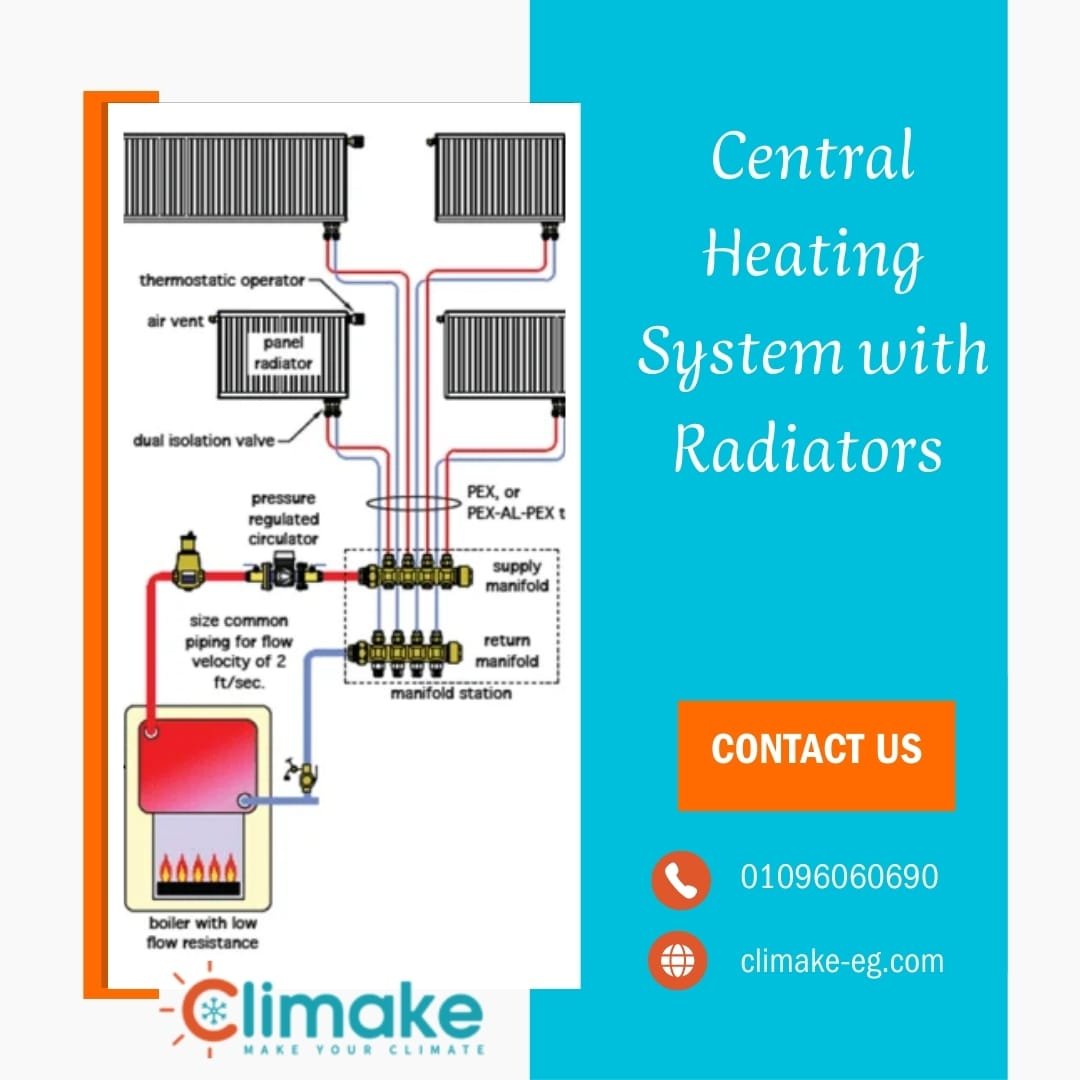Central Heating Systems, A boiler is connected to radiators and pipelines in a central heating system. The boiler produces heat, and warm water is transferred from it to the radiators via pipes and then returned to the boiler for reheating. It also distributes hot water to the hot taps in your home.
Generally speaking, boilers come in two varieties:
- A traditional boiler system consists of a room thermostat, a pump, and a programmer. The programmer allows you to operate the hot water and heating independently. Usually located in your airing cupboard, it heats hot water and stores it in a cylinder.
- A combination boiler, or combi boiler, is a system that includes both a thermostat and a programmer. Since it heats hot water as needed, it just needs to regulate the heating. There is no need for a cylinder to hold hot water because it is available as soon as the hot water taps are turned on.
What is a Central Heating System?
A Central Heating System provides warmth to an entire building or home from a single central source. This system distributes heat through pipes, radiators, or ducts to ensure consistent and efficient heating across all rooms. It’s a modern and convenient solution for maintaining a comfortable indoor environment during colder months.
Why Are Central Heating Systems Essential?
Central heating systems are essential for maintaining comfort and health during winter. They ensure a stable indoor temperature, protect pipes from freezing, and contribute to overall well-being by providing a warm and cozy atmosphere.
Types of Central Heating Systems

Gas Central Heating Systems
Gas systems are the most common type, using natural gas to heat water in a boiler. The hot water is then distributed through radiators or underfloor heating pipes.
Electric Central Heating Systems
Electric systems rely on electricity to heat water or air. They are easy to install and ideal for homes without access to gas lines, though they can be more expensive to operate.
Oil Central Heating Systems
Oil-based systems are common in rural areas where gas supply is limited. They use oil stored in tanks to heat water, providing reliable heating for homes and businesses.
Renewable Energy-Based Central Heating Systems
These systems use sustainable energy sources like solar panels, heat pumps, or biomass to provide heating. They are eco-friendly and can significantly reduce energy bills.
How Do Central Heating Systems Work?
The Role of Boilers and Furnaces
The boiler or furnace is the heart of the system, heating water or air. The heated medium is then distributed throughout the building to provide warmth.
Heat Distribution Through Radiators and Ducts
Radiators and ducts play a crucial role in spreading heat evenly. Radiators emit heat into rooms, while duct systems circulate warm air.
Thermostats and Temperature Control
Thermostats allow users to set and maintain their desired temperature. Modern systems often include smart thermostats for precise control and energy efficiency.
Benefits of Central Heating Systems
Consistent and Efficient Heating
Central systems provide uniform heating throughout the home, eliminating cold spots and ensuring maximum comfort.
Cost-Effectiveness Over Time
While the initial installation cost may be high, central heating systems are energy-efficient, leading to long-term savings on energy bills.
Environmental Impact and Sustainability
Renewable energy-based systems significantly reduce carbon emissions, making them an environmentally responsible choice.
Central heating controls
The controls for your hot water and central heating may differ depending on the sort of system you have.
thermostat in the room
Your home’s temperature is controlled by the room thermostat. It is typically found in the dining room, lounge, or hallway and senses the temperature surrounding it to accomplish this. The thermostat signals the boiler and central heating pump to stop supplying hot water to the system when the air surrounding it reaches the desired temperature. After that, your radiators will cool. The thermostat signals the system to resume pumping hot water to your radiators when the air cools.
Your radiators will feel warmer and colder at different points during the day to maintain a consistent temperature.
Depending on how warm or cold they feel, many people set their thermostat to between 18 and 21 degrees Celsius and then modify it to their preference. Remember that you can save on fuel costs annually by lowering your thermostat by 1°C. Make sure you are still comfortable before lowering the temperature.
Thermostatic radiator valves
These valves regulate the room’s temperature and are attached to individual radiators. When the desired temperature is attained, they cut off the water supply to the radiator. Every room, with the exception of the bathroom, hallway, and the room with the thermostat, often has a valve attached to the radiator.
They are typically white, located at the radiator’s side, and have a dial with the numbers *12345 surrounding it. To check if the room is warm enough, people frequently set the valve to the middle setting (3), which is roughly 20°C.
Turning them completely “ON” or “OFF” to change the temperature of the room is not a smart idea because this will waste fuel.
Programmer
You may preset the time when your heating and hot water will turn on and off using a control panel called a programmer. You can have the option of selecting heating only, hot water only, or both heating and hot water, depending on the type of programmer. Note: The panel only controls the heating if you have a combi boiler.
It can be programmed to switch the heating on and off or to switch it on and off once or twice a day. The majority of users program it to turn on twice a day, in the morning and the evening. Configure your system to activate approximately half an hour before you want the house to warm up and half an hour before you want it to cool off.
Two categories of programmers exist:
- Digital/electronic: Your central heating system is most likely controlled by a digital programmer if you recently purchased a new boiler. This is frequently located in your kitchen, hallway, or airing cupboard.
- Time clock: To adjust your heating, these programmers contain a clock with either sets of pins or arrows.
You can consult your programmer’s user manual if you need to reset it. If your system does not include a programming user manual, look it up online or give the Housing Repairs team a call, and we will send one to you.
Thermostat for boilers
This regulates the water temperature surrounding the radiators and ought to be adjusted in accordance with the boiler’s manufacturer’s recommendations. There are two in combination boilers: one for hot water and one for heating.
thermostat with a cylinder
A cylinder thermostat will be installed in your hot water cylinder to regulate the water’s temperature. The ideal temperature for this is about 60°C (140°F).
Key Components of Central Heating Systems
Boilers and Furnaces
These components generate heat, either by burning fuel or using electricity.
Radiators and Heat Emitters
Radiators transfer heat into rooms, while underfloor heating systems distribute warmth evenly.
Thermostats and Smart Controls
Advanced controls allow users to optimize energy use and maintain a comfortable temperature.
Pipes and Ductwork
These systems transport heat from the source to different parts of the building.
Installation of Central Heating Systems

Planning and Design
Proper planning ensures the system meets the building’s heating requirements efficiently.
Professional Installation
Hiring certified professionals ensures safe and effective installation.
Safety Considerations
Regular checks and compliance with safety standards are vital to avoid risks like gas leaks or electrical faults.
Maintenance and Troubleshooting
Regular Maintenance Tips
- Schedule annual boiler servicing.
- Bleed radiators to remove trapped air.
- Check thermostat functionality.
Contact us to get the best quality and lowest price.
Common Problems and Their Solutions
Issues like uneven heating or strange noises can often be resolved by a professional inspection.
When to Call a Professional
If you notice persistent issues or a drop in system efficiency, it’s time to seek expert help.
Choosing the Right Central Heating System
Factors to Consider
- Size of the building.
- Type of fuel available.
- Budget for installation and operation.
Contact us to get the best quality and lowest price.
Comparing Different Systems
Evaluate energy efficiency, upfront costs, and long-term savings before making a decision.
Central Heating vs. Other Heating Methods
Central Heating vs. Space Heaters
Central heating provides consistent warmth for the entire building, while space heaters are ideal for single-room heating.
Central Heating vs. Underfloor Heating
Underfloor heating offers even heat distribution but can be costlier to install compared to central systems.
Environmental Impact of Central Heating Systems
Energy Efficiency Ratings
Choose systems with high energy efficiency ratings to minimize environmental impact.
Reducing Carbon Footprint
Opt for renewable energy-based systems or hybrid solutions to lower emissions.
Transitioning to Renewable Energy
Invest in solar panels or heat pumps to make your central heating system more sustainable.
Future Trends in Central Heating Systems
Smart Heating Systems
Integration with smart home technology allows for remote control and enhanced energy management.
Integration with Renewable Energy
The future of heating lies in systems that combine traditional methods with renewable energy sources.
Advances in Heating Technology
Innovations like hydrogen boilers and ultra-efficient heat pumps are paving the way for greener heating solutions.
Central heating systems are a cornerstone of modern comfort and efficiency. Whether you’re upgrading your current system or installing a new one, understanding the options and benefits can help you make an informed decision. With advancements in technology and a shift towards renewable energy, central heating systems are becoming more sustainable and user-friendly than ever.
Contact us to get the best quality and lowest price.
FAQs
- Which three kinds of heating systems are there?
Three primary categories of systems exist:
Heating in the center: A central heat source is used in central heating to produce heat. After that, the heat is transferred throughout the house. Ductless heating: Refrigerant lines, rather than ducts, are used by ductless heat pumps to transfer heat.
Direct heating: This method also eliminates the need for ducting. - How long does a central heating system last?
Most systems last 15–20 years with proper maintenance. - Can I install a central heating system in an older home?
Yes, but additional modifications may be required to accommodate the system. - What are the most energy-efficient central heating options?
Renewable energy-based systems like heat pumps or solar-powered systems are the most efficient. - How can I reduce my central heating energy bills?
Regular maintenance, using smart thermostats, and upgrading to energy-efficient systems can help reduce costs. - A central heating management system: what is it?
Boiler controls, sometimes referred to as central heating controls, are any devices that assist in controlling the heating of an entire building or individual rooms. This covers thermostats, timers, and programmers. They can assist households in conserving energy, which ultimately results in financial savings. - What is an HVAC system?
How Do Central Air Conditioning and Heating Systems Operate? The process of central heating A thermostat senses the temperature and activates the HVAC system, which is how all central heating and cooling operations begin. Heat pumps function similarly when used for cooling and share parts with split-system air conditioners.


